All about terry freesia
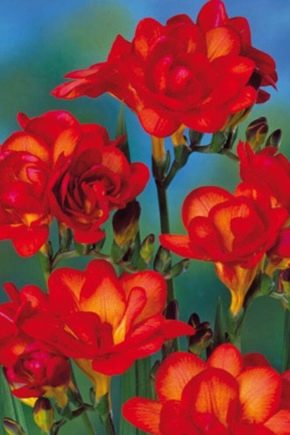
Freesia is a flower with an exquisite aroma, not inferior in its beauty to luxurious roses, lilies and orchids. You will learn all about the care and cultivation of terry freesia in this article.
Description of the flower
A wonderful guest from Africa has long won the hearts of gardeners. A herb of the Iris family came to Europe thanks to the German doctor Friedrich Frese, a fan of the exotic flora of the hot continent.
Breeders have developed many varieties of terry freesia in bright colors and shades that do not grow naturally. The progenitors of the hybrids were Armstrong's freesia and the broken one.
The main difference between terry freesia and ordinary freesia is the arrangement of its bell flowers on the branch. In the hybrid developed by scientists, they are arranged in two rows, and in a simple freesia they grow in one line. Due to this grouping of flowers, terry varieties look elegant and lush.
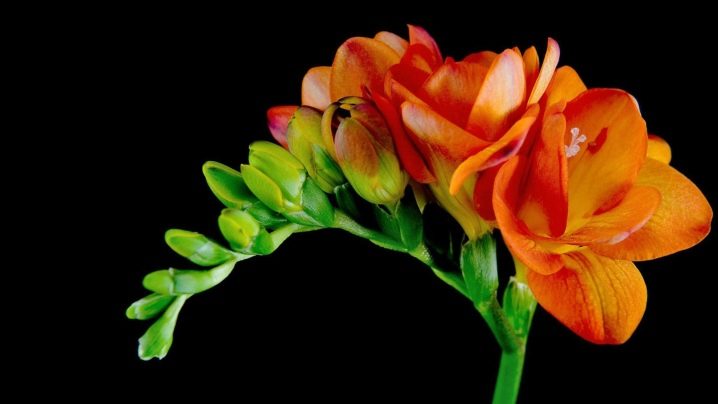
One copy grows up to 5 peduncles. The flowers of the plant are collected in an oblong bunch of 10-12 pieces. The largest and most lush inflorescences are located at the base of the peduncle. Above, half-open buds grow, resembling miniature roses. The top of the bunch is crowned with tightly closed oblong buds, resembling small beans.
The diameter of the funnel-shaped flowers is from 5 to 8 cm, their length is from 5 to 7 cm. Smooth, tightly spaced petals with a glossy shine are decorated with a winding border. She creates a bizarre terry effect in these varieties of culture.
The leaves of the plant are smooth, narrow, with a pronounced longitudinal vein and a sharp end, resembling a dagger in shape. The stem is glabrous, perfectly branched. Its height is from 40 cm or more, depending on the variety of plants. Bushes grow in height from 50 to 100 cm. Miniature species - from 25 to 35 cm.
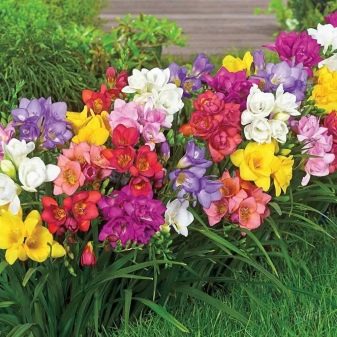
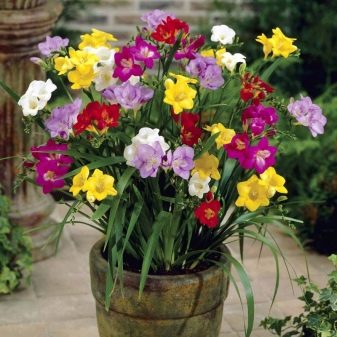
Popular varieties
Terry, or, as scientists say, "full" freesia, delights with the richness of colors and unique aroma. Each hybrid freesia color has its own unique scent.
Let's take a closer look at popular varieties.
Alba
A snow-white beauty with yellow segments on delicate petals, as if she were made of porcelain. The plant is resistant to cool climates. Suitable for indoor cultivation. The height of the bush is not higher than 50 cm. Flowering time is July-August.

"Bordeaux"
Mix of burgundy, red and lilac shades. A bright accent is the yellow middle of the throat with white piping. The variety blooms from July to early September.

Double blue
Has a rich violet color. The height of the bushes is not more than 50 cm. Up to 12 lush flowers with a diameter of up to 8 cm are collected in racemose inflorescences. The variety is frost-resistant, blooms profusely at the end of July.
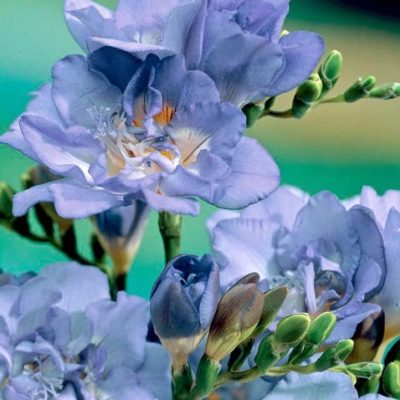
"White"
The snow-white flower is a favorite of florists; it looks solemn and tender in bouquets. Transforms flower beds and indoor flower beds. Up to 12 fluffy inflorescences open on a high peduncle. The variety blooms from July to late autumn.
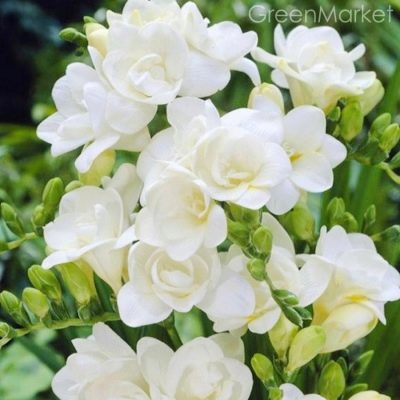
White swan
The variety with the romantic name "White Swan" has snow-white flowers with pale cream stripes. On a powerful peduncle, from 8 to 12 fragrant inflorescences bloom. The plant pleases with flowering until September.
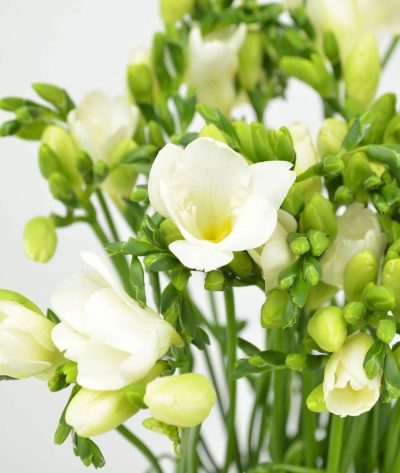
"Pink flamingo"
An ornamental variety with bright pink flowers and purple splashes. Plant height - 80 cm. Flowers with a diameter of 7.5-8 cm are collected in a bunch of 8 pieces on a peduncle 30-35 cm high. The plant blooms until early October.
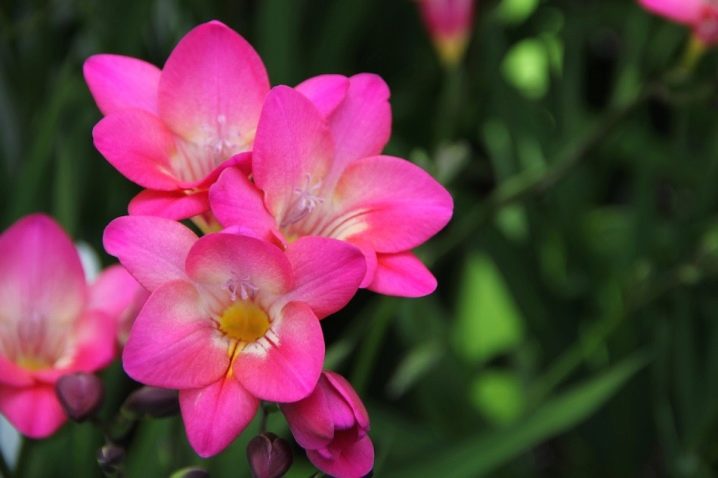
Sunbeams
Dutch variety with juicy yellow-orange large flowers and a delicate sweet smell. The plant produces up to 4-5 flowering shoots per season. Suitable for creating bouquets and compositions, planting in a flower bed and forcing at home.
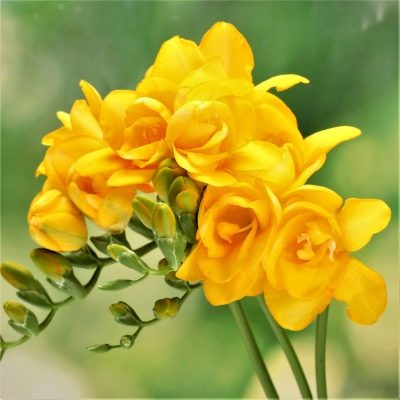
"Ballerina"
The variety is white and red. Flower petals are large, have a corrugated structure. Peduncles grow up to 35 in length, each branch reveals up to 12 flowers.
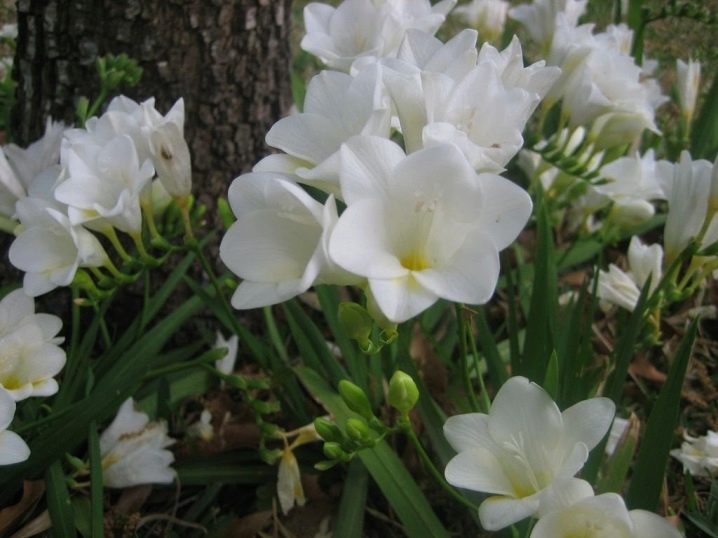
"Mix"
A mixture of multi-colored bulbs of the Freesia Double type. Freesias "Mix" are suitable for growing both in the house and in the garden. Bushes reach a height of 40 cm, on peduncles there are up to 12 flowers with a diameter of up to 7 cm.
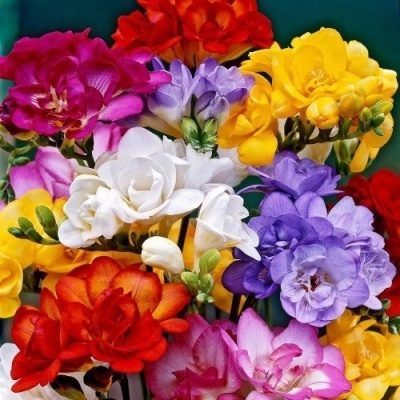
Planting and leaving
The condition of the bulbs is checked before the sowing season. They select healthy, dense corms, without signs of disease. The material is soaked for 25-30 minutes in a 0.2% solution of Fundazol or potassium permanganate.


Before planting on a flower bed, the bulbs are germinated at home:
- planted in pots with light soil, to a depth of no more than 5 cm, in a warm, bright place;
- by mid-May, the shoots are moved to open ground, containers or pots - to their permanent residence on the balcony.
Flowers are planted in a sunny place or partial shade on an area with loose and fertile soil, in a trench 11-12 cm deep, at a distance of 5 cm from each other and 10 cm between rows. If the soil is heavy, the plants are added dropwise by 7-8 cm. It is better to place the bulbs in moist soil, and after planting, cover them with earth.
For homemade freesias, soil is prepared from compost soil, peat, sand and humus in equal proportions. Planting depth - 2 cm, distance between plants - from 3 to 5 cm. The room temperature is maintained at 16-18 degrees.
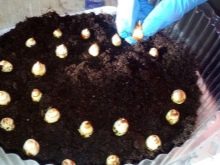
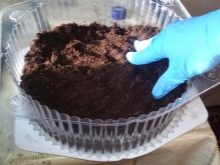
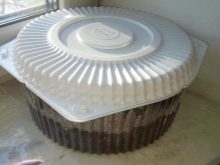
Basic rules for caring for a capricious terry beauty.
Proper watering
The plant does not like dryness and waterlogging.... The top layer of the earth must dry out before wetting again.
During the forcing of the freesia bulbs, watered moderately, and during the flowering period - abundantly. In the hot summer season, the bushes are sprayed.
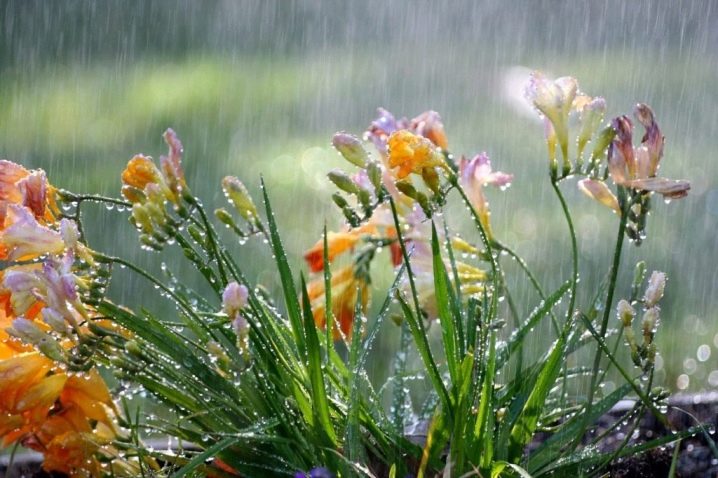
Lighting
Direct sunlight is harmful to freesia. The ideal place for a plant in the house is a western window, where there is diffused sunlight. In winter, freesia needs additional lighting.
A place
In a room with flowers, there should be no drafts and temperature changes. The windowsill should be warm in cold weather to avoid rotting of the bulbs. The optimum temperature in the house is from 20 to 22 degrees.
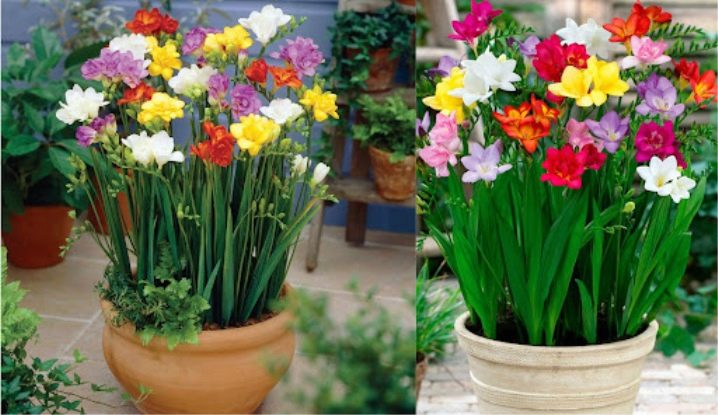
Top dressing
During the growing season, plants are fed 2 times a month with ammonium nitrate. At the time of flowering - phosphorus-potassium fertilizers. In cold weather, abundant watering and feeding is reduced to a minimum.
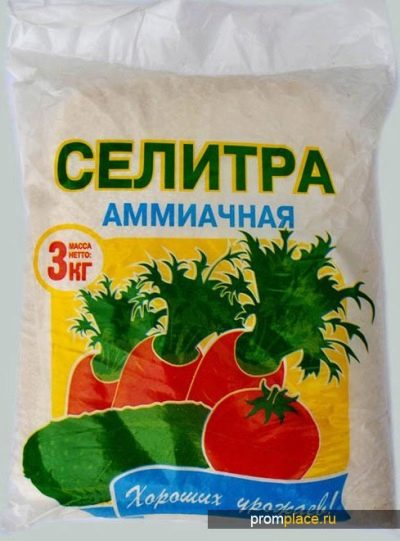
Inspection
Plants are regularly inspected. Dried leaves and buds are removed, bushes are tied up, foliage is processed when there are signs of disease. In late autumn, before preparing for winter, the bulbs, in which the aboveground part has dried and died, are dug out for storage.
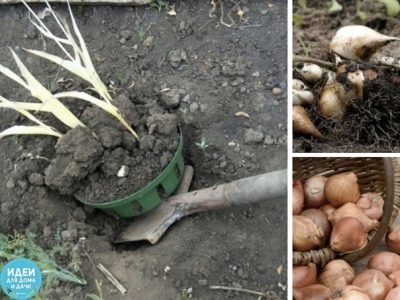
Reproduction
By dividing
A healthy onion is cut into several pieces with a sharp, clean knife, so that each has a kidney. Places of cuts are treated with activated carbon, dried and used for planting.
Children
Young corms are carefully separated from the mother and tied in a gauze bag on a battery above a container of water in order to maintain the desired microclimate for planting material until next spring, and then planted in the soil.
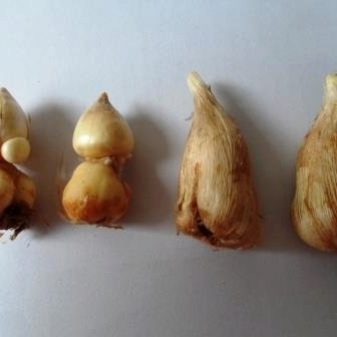

Seeds
Traditionally, freesia is propagated by seed breeders. Seed material is taken from fresh healthy plants, disinfected and planted for distillation in sandy soil in a room with warm and humid air.

Cuttings
A complex and time-consuming method is used in laboratory conditions in nurseries.
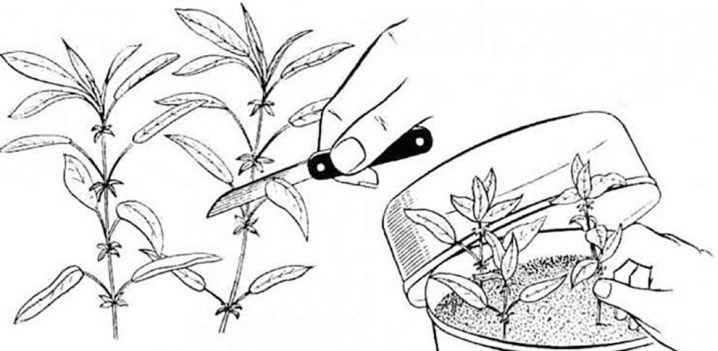
The most problem-free and convenient method, gardeners recognize the reproduction of terry freesias by bulbs.
Diseases and pests
Fusarium
The causative agent of the disease is the fungus Fusarium. The reason for its appearance is improper watering, sour soil or overdried substrate.Harmful insects can also carry the disease. Leaves turn yellow on diseased plants, mosaic white spots appear.
Plants are treated with drugs:
- Fitolavin;
- "Gamair";
- Previkur;
- "Agat-25 K";
- Fitosporin-M.

Black spot
Black spots appear on the leaves of the plant. Reason - improper care, deficiency of phosphorus and calcium. The preparations "Hom" and "Oksikhom" help to fight the disease.
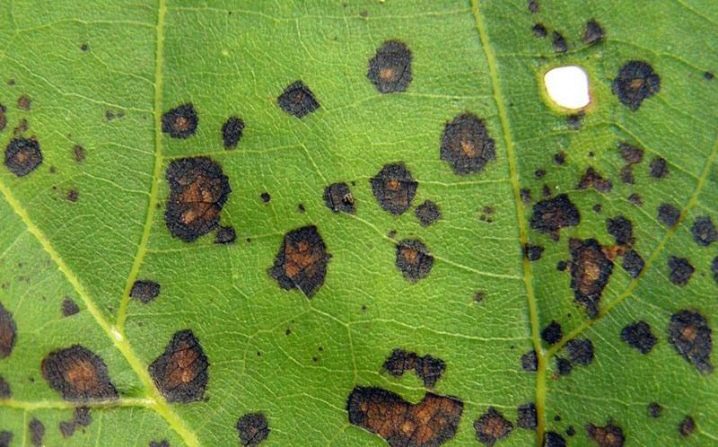
Mosaic
The leaves of the bushes are covered with yellow spots with a black edging, and then dry out and become translucent. Sick areas of leaf plates are treated with "Fundazol" or the following composition:
- 75 g malofos;
- 10 liters of water.
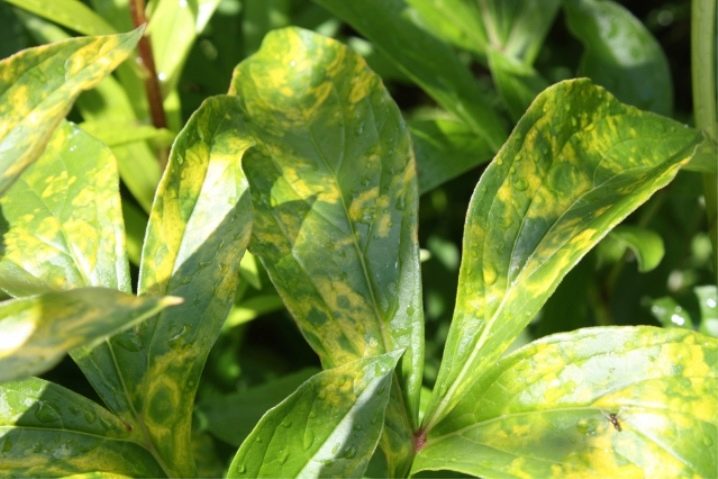
White rot
Freesia leaves turn yellow and die, the bulbs are covered with black spores of the fungus. The disease appears when freesia bulbs are not properly prepared for wintering. It is important to treat them with potassium permanganate or fungicide before storing them for the winter.
Root nematodes
Means of prevention: before storage, soak the bulbs for 3 hours in boiled water at a temperature not exceeding 43 ° C.
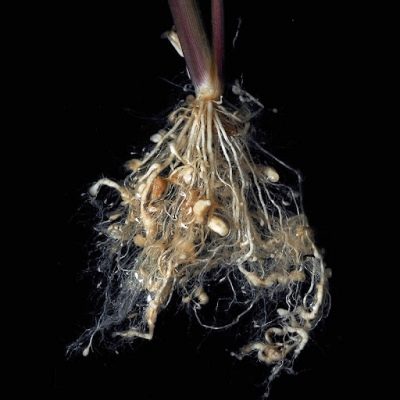
Spider mite
A cobweb on the leaves is a signal of the appearance of a tick. The drugs will cope with it Aktellik and Fitoverm. It is good to pre-treat the plant with a solution of laundry or green soap.
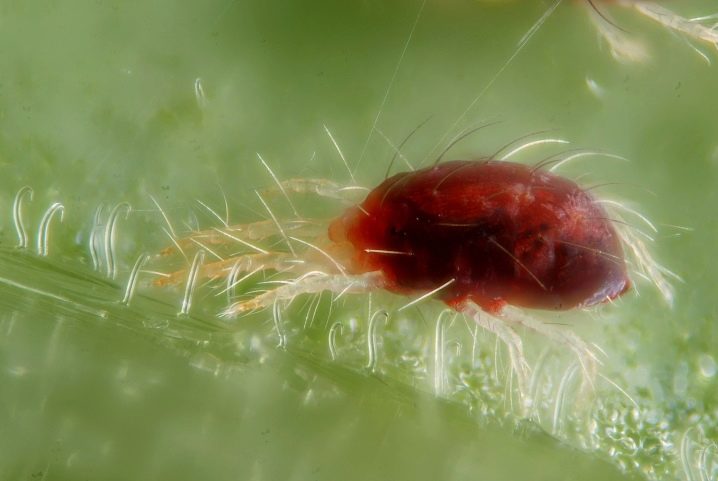
Whitefly
The appearance of a butterfly is indicated by sticky droplets on the seamy side of the leaves. Sick specimens are washed with green soap and treated with a fungicide.
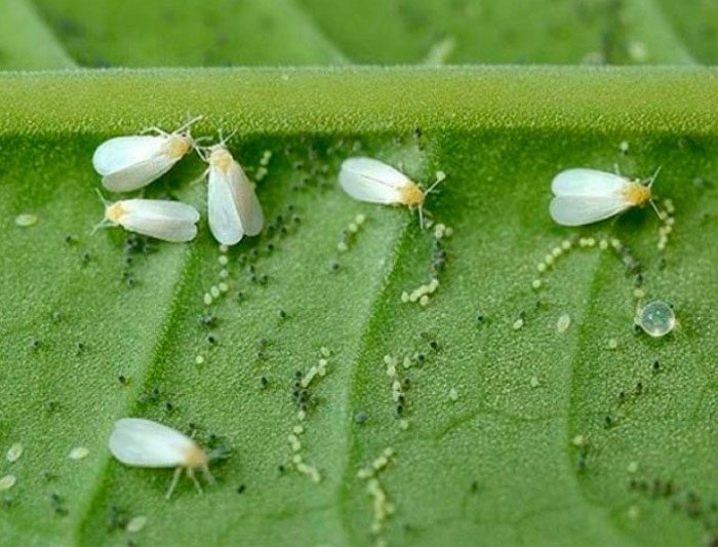
Aphid
Uninvited guests are actively moving around the plant. Infected leaves are "swept" with a wide brush, brushing insects into a jar. The flower is washed under a powerful stream of water and treated with preparations "Commander", "Confidor", "Biotlin".
Thrips
Insecticides help fight thrips Iskra, Vertimek, Aktara, Agravertin, Mospilan. Solutions of drugs are made for spraying and watering at the root.
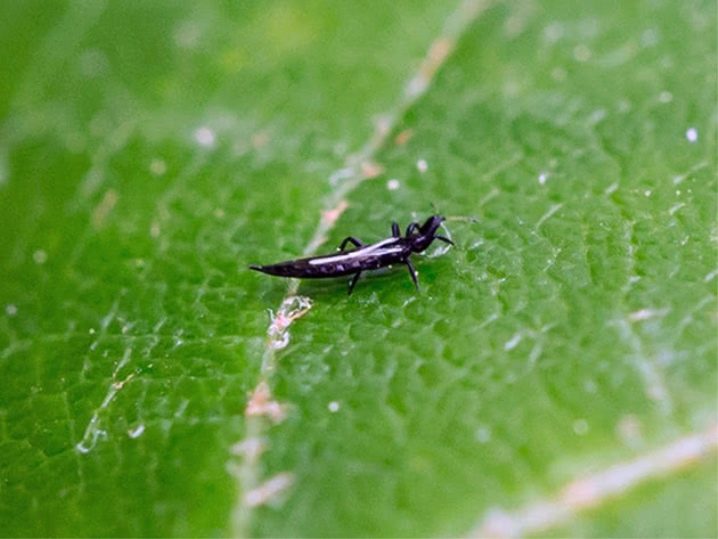







































































































The comment was sent successfully.